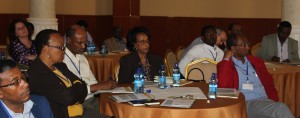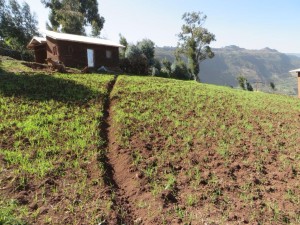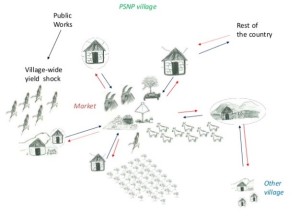Many changes have taken place in Ethiopia during recent years, with agricultural, economic and diet transformation clearly apparent. The Ethiopian Government’s sizable interventions and investments targeting poverty and growth in many sectors, is showing positive impact on economic growth and on the most vulnerable people in the country.
This symposium held on May 27th 2016, and organized by ESSP in collaboration with EDRI, showcased the research that has taken place in Ethiopia in four key areas:
- Economic transformation and employment
- The impact of PSNP
- Agricultural transformation
- Nutrition and diet transformation
The event provided a platform to impart unique knowledge about Ethiopia, and opportunity for rich discussion to further shape the quality of the research findings.
The audience indicated a strong interest in economic and agricultural transformation. Hence, Paul Dorosh’s introduction on structural economic changes and employment implications to wage levels, captured attention with solid evidence that showed how Ethiopia is moving out of agriculture and into other sectors. Fantu Bachewe further compared wage changes between rural and urban communities, revealing huge changes and differences in these communities. EDRI’s Firew Woldeyes noted that although these wage changes have occurred, the youth are still engaged in agriculture. He considered how government policies could help increase opportunities for young people to ascend from a life in agriculture and diversify skills into non-farm income activities. Moreover, since agriculture plays such a large part in the livelihood of rural communities, building security into land tenure for farmers is crucial in driving improved practices to intensify land and increase efficiencies. Thus, Africa’s largest land certification - second-level land certification – has been under the spotlight for research enquiries in recent times (see Hosaena Ghebru et al.).
Alemayehu Seyoum Taffesse set the scene for the Productive Safety Net Programme (PSNP) which targets poverty and vulnerability. Since 2006, when the PSNP began, continuous improvements have taken place as a result of feedback through detailed rounds of surveys conducted by ESSP and other institutions. During the symposium, a number of researchers considered specific aspects of PSNP, such as the timing and nature of cash transfers, effect on yields, and the remaining food gap on national and local scales. The impact of PSNP is shown to go beyond the household, with effects detected in the extended community. Edward Taylor and Mateusz Filipski used modelling techniques to assess the spillover effects from PSNP payments (see Figure 1), concluding that the total benefits exceed the government’s cost.
Figure 1: Illustrating PSNP spillovers (see presentation on PSNP and its impact on village economies)
Continuing on the transformation theme, Bart Minten presented the research on agricultural growth in Ethiopia, noting that the biggest growth has been in yields. Improved land intensification techniques adopted by farmers, such as the use of fertilizer and improved seeds, have been the major contributor, but what have been the drivers? Minten noted four factors: extension, incentives, education and connectivity. The latter was described further in the context of urbanization and the impact this is having on agriculture. Seneshaw Tamru graphically illustrated changes in multiple variables along the transport cost gradient from Addis Ababa, and considered the direct and indirect effects of these variables, along with their implications on policies. Patterns of a different nature were seen in the research conducted on prices of cereals and livestock during the current drought, and the effect on wages. Feiruz Yimer and others compared figures from a previous drought in 1997/8, and found that there does not appear to be large-scale effects of drought on cereal prices, BUT there still is a clear and urgent need to assist the affected people.
From a different angle of research, Alemayehu Seyoum Taffesse described two concepts of aspiration (important for analyzing and addressing behavior) and the locus of control (the beliefs surrounding the cause of events in one’s life). In general, poverty lowers the locus of control, and therefore poor people do not aspire to change. This mindset discourages investment and hence people tend to remain in poverty. Alemayehu pointed out that there is much more to be learnt in this area and how motivational policies can influence change.
In the final section of the symposium, the focus was on nutrition and diet transformation, with Ibrahim Worku first describing how diet is changing in Ethiopia with increased income and a change in the consumption basket. The research shows clear contrasts between the rural and urban food baskets, with different cereals (and their quantities) and types of foods dominating these different baskets. Bart Minten explained further how market access plays a critical role in welfare and nutrition, noting that remoteness from markets links closely with poverty. Further to this, Kibrewossen Abay explored the seasonality aspects on child growth and the role market access plays. Clear patterns emerge from the research, illustrating the links between multiple factors. Further extending this research, Kalle Hirvonen considered education in this complex equation, showing the impact of nutritional knowledge on children’s diets and their wellbeing.
This symposium, describing ESSP’s cutting-edge research, brings current and relevant research topics to the forefront, and in doing so helps to improve the decision-making process in Ethiopia.
To read more about the research presented during the symposium, there are Working Papers, Research Notes and presentation slides available on line.
Please subscribe to receive regular updates on ESSP’s work and its quarterly newsletter.




